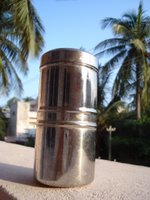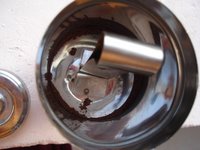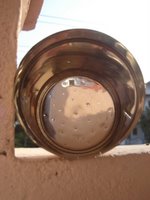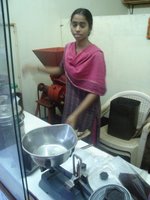 There are many serious cultural differences between south and north India. To my mind, the most profound is: coffee. In the north, it's chai. Here, it's coffee. Happily.
There are many serious cultural differences between south and north India. To my mind, the most profound is: coffee. In the north, it's chai. Here, it's coffee. Happily. I can date with some precision the beginning of my interest in the issue of coffee drinking in India. Before coming to India, I spent several months with my dear friends Karen Derris and Ed Murphy, as I waited for the Fulbright to secure Indian research visas for its scholars. To call Ed a coffee drinker would be woefully inadequate. In fact, Ed has his coffee beans flown in from his favored plantations in Nicaragua and other such places and grinds the beans seconds before brewing his coffee. Coffee in their home was readily available, and Ed was very concerned as to how I would have continued access to coffee once in India. I planned to be in the north where tea (or ‘chai’) is everywhere and coffee nowhere. At one point, Ed was advocating that I learn how to roast my own beans, as unroasted beans keep longer and could be shipped to me green from time to time. I dragged my feet a bit there, and explained that anyway, I take milk in my coffee. Milk means refrigeration, but in Sarnath where I then expected to spend most of my time, there are scheduled power outages from 9 am to 5 pm daily. This led Ed to propose other solutions for me. The suggestions he pitched ranged from carrying a generator with me to India (um, that might be a bit heavy, no?) to procuring a Lister Engine (a what?). In the end, he sent me off to India with a handy one-cup gold filter.
When I first arrived here, I was traveling with my good friend Chela, who is Cuban, as long as we are speaking of avid coffee drinkers…. Chela bought five kilos of excellent coffee at a little shop we found in Delhi. We begged hot water here and there, and used my handy filter to brew ourselves some fine cups of coffee during the month we were together. Some fine cups, yes, but certainly not five kilos’ worth. She carried those bags of coffee with her around the country until she left, and then willed it to me.
But all this was before I knew I’d be in south India, where coffee is very much the caffeinated beverage of choice, taken with warmed milk and, usually, sugar. Which brings me to the supposed point of this blog entry: The material culture of coffee-making in the south.
 What you see pictured here is a ‘coffee filter’ a $2 kitchen appliance in the stainless steel that is a staple of Indian kitchen (see the coffee cups as well.) This beautifully simple technology is all you need to make a fine cup of strong coffee. The coffee beans are ground to a fine powder, finer than we might grind for espresso makers, and this powder is then placed in the top half of the coffee maker.
What you see pictured here is a ‘coffee filter’ a $2 kitchen appliance in the stainless steel that is a staple of Indian kitchen (see the coffee cups as well.) This beautifully simple technology is all you need to make a fine cup of strong coffee. The coffee beans are ground to a fine powder, finer than we might grind for espresso makers, and this powder is then placed in the top half of the coffee maker.  As you see, the holes are tiny, and to compound matters, the other device you see is placed on top of the coffee powder in the filter to tamp it down. On top of that goes boiling water, and then it is covered to allow it to drip down. The first time I tried it, I thought I was doing something wrong, as it took so long to drip down that the coffee had begin to cool off. No, I was told, that is why the milk needs to be very, very hot.
As you see, the holes are tiny, and to compound matters, the other device you see is placed on top of the coffee powder in the filter to tamp it down. On top of that goes boiling water, and then it is covered to allow it to drip down. The first time I tried it, I thought I was doing something wrong, as it took so long to drip down that the coffee had begin to cool off. No, I was told, that is why the milk needs to be very, very hot.

Have you begun yet to wonder why a Buddhist nun is devoting an entire blog entry to coffee? After I first ordained, my youngest brother Dan said, “So now you’ll have to give up coffee, right?” Dan was much more health-conscious than I, never drank coffee or caffeinated tea himself and was clearly pleased at the prospect of my giving up coffee. I was equally pleased to tell him that in fact, Buddhist monks in Japan are sometimes credited with discovering green tea, which they valued greatly for its benefits in supporting alertness during long meditation sessions. Whether or not this is so, the fact remains that Buddhist monastics take no vow against consuming caffeine. Alcohol? Definitely off-limits. Coffee? Coming right up…how do you take it?
Vow or not, coffee is not among the objects we are expected to renounce. Of course, as with anything else, we must take great care not to allow ourselves to become dependent or emotionally attached to the objects we like, eagerly seeking them out and mourning their absence. … The point is not to deprive ourselves of all enjoyment, but to learn to enjoy without becoming attached to the object, or to the experience of it.
As committed Buddhist practitioners, what we strive to renounce is our attachment, not necessarily the objects of pleasure. The difference, you see, is in the mind.

2 comments:
The other great virtue of S India is the 17 rs rice plate eaten with yogurt, no utensils, and unlimited sabzi. You have found this, no? In the part of India where the ocean is to the east, its often served on a banana leaf. Also coconuts. And can you chew paan? There was some debate over that at Drepung, and my teacher was worried that they would put "dex" [eng: drugs? dexedrine] in with the supari.
Affirmed, coffee is definitely the drink of choice in the south, and it definitely whoops the whatsies off tea. I was always concerned about malcaffeination in Ladakh.
price of thali has gone up a bit, i'm afraid.
no paan for me. it's not specifically prohibited as far as i've seen, and i've been to some functions where i was confident it was not spiked (not that this had ever occurred to me) but... have you ever tasted it? no thanks!
Post a Comment